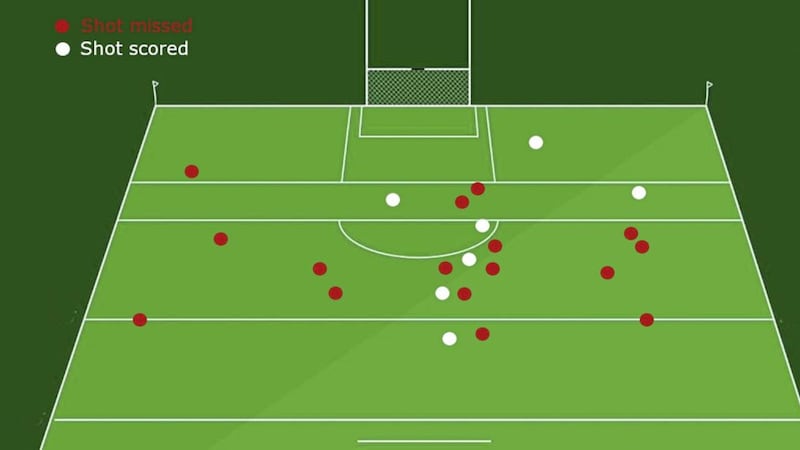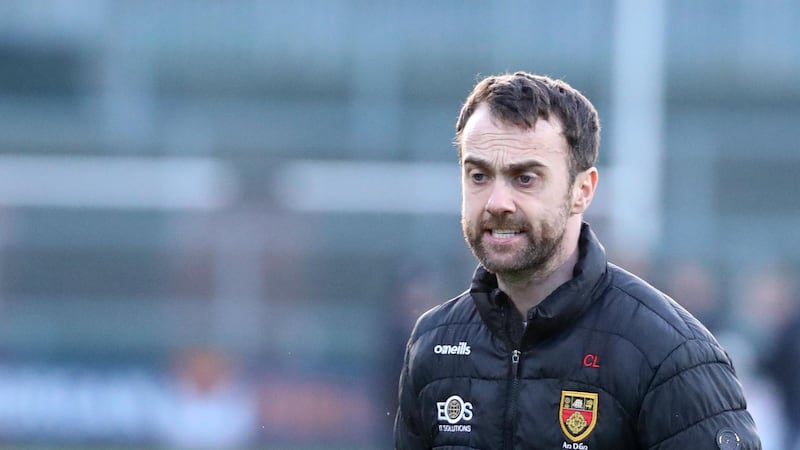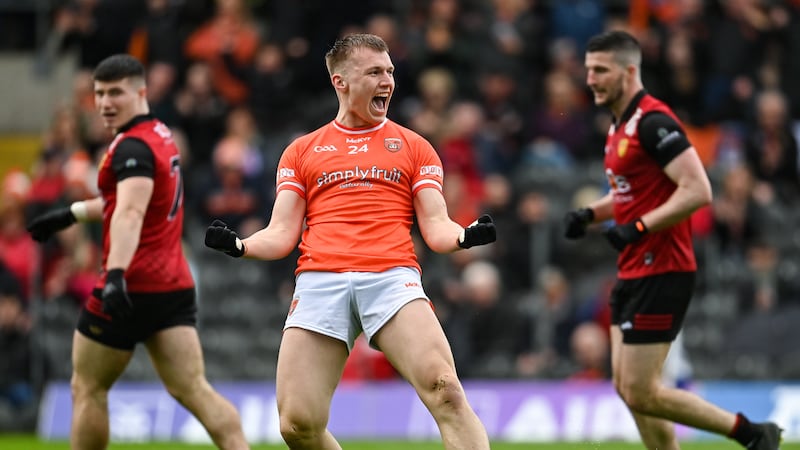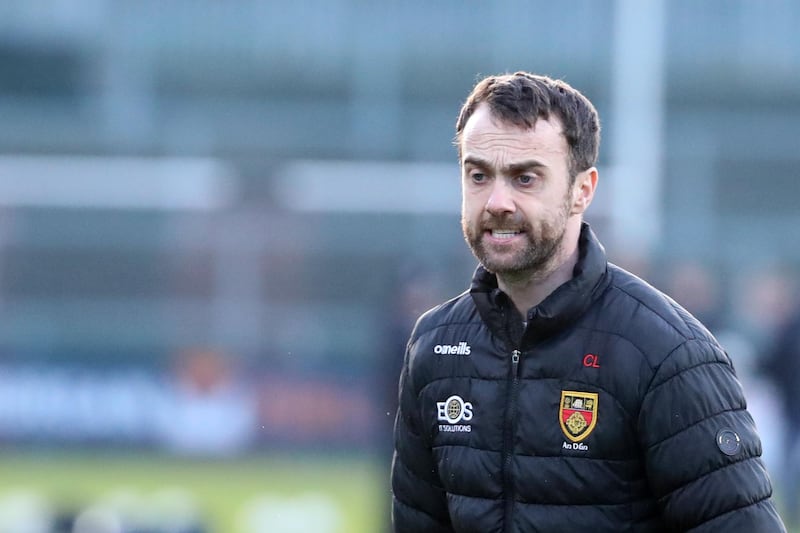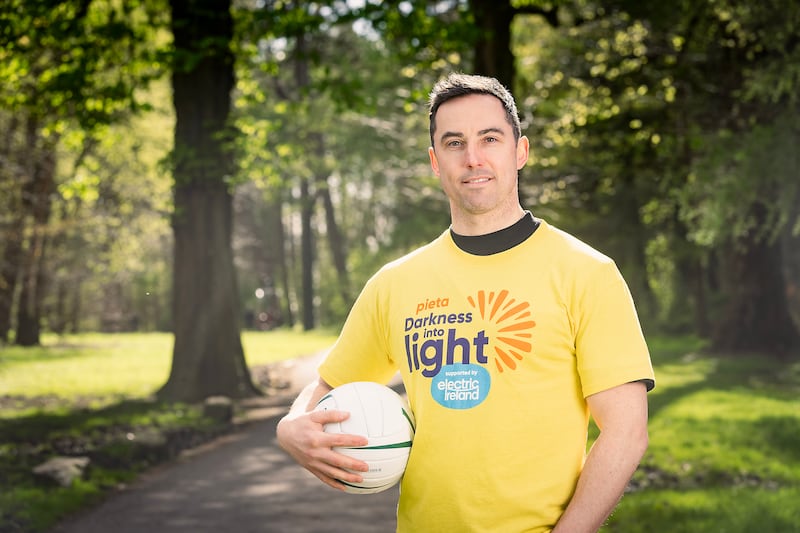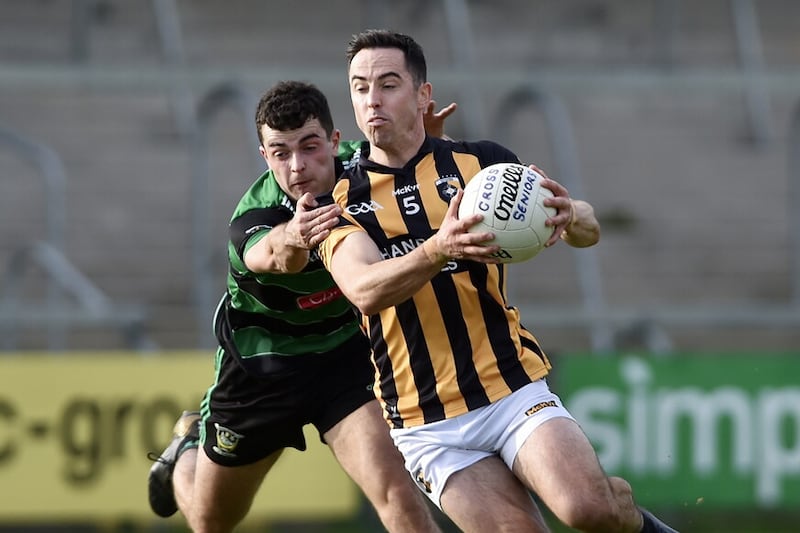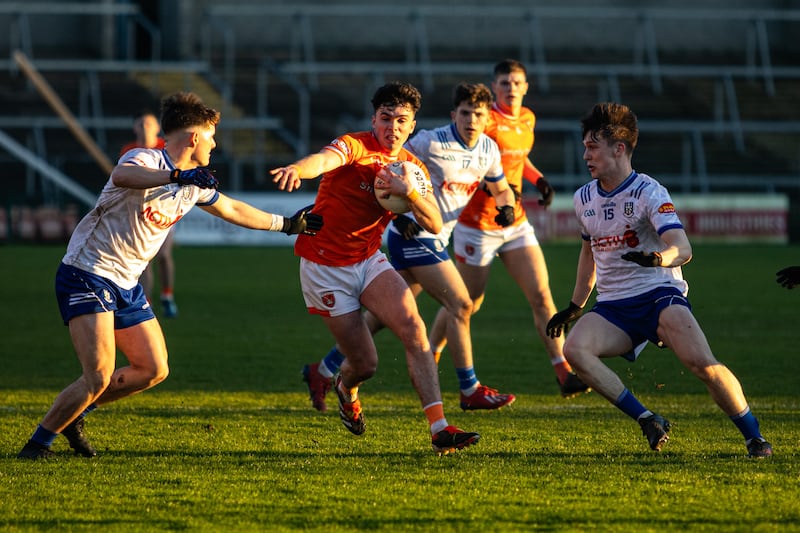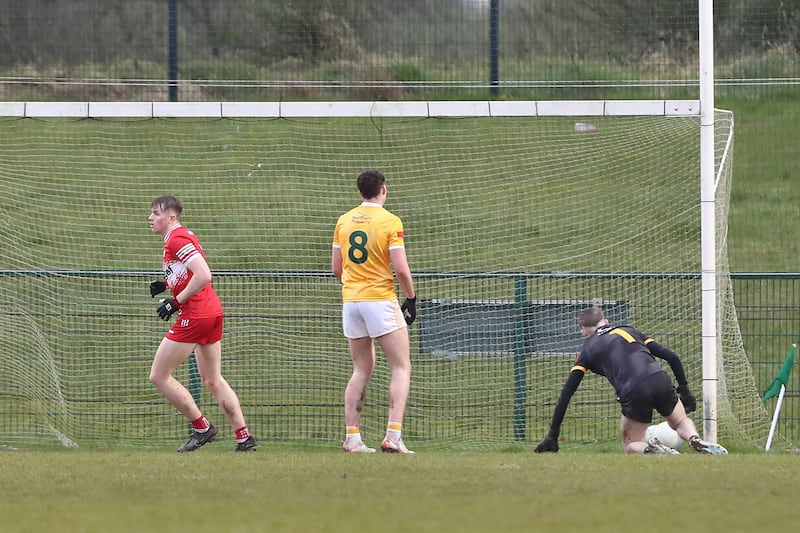IT’S that time of year again, when the Ulster Championship rolls around and the fact that Kieran McGeeney hasn’t won a game in it as Armagh manager gets wheeled out.
The draws have not been all that unkind to them. Donegal in their first outing was undoubtedly the toughest, but since then a Cavan side that’s won just three Ulster SFC games this decade, their on-par rivals Down and then a well-organised but somewhat limited Fermanagh doesn’t represent the toughest the province can offer.
What those three all did offer was defensive solidity. Down only offered it in the second half, and the chalk-and-cheese nature of that game’s two periods ultimately shone the brightest light on why Armagh have such a poor record in Ulster.
Through the back door, where games are that bit looser and more natural, they’ve thrived. The last two years they’ve reached an All-Ireland quarter-final and lost an epic round four shootout to Roscommon. For a side that has bobbed between Division Two and Three in the league, that’s a fair decent consistency.
But their Achilles’ Heel has been unpicking the lock of a team that protects the middle of its goal well. They scored just 0-8 against Donegal, 0-7 against Fermanagh and, once Down shut the doors at half-time, just two points in the second half. The All-Ireland quarter-final loss to Tyrone was the most sobering, where they were swallowed up and spat out on the break.
Why, though, does this happen?
The flaws of the kicking game
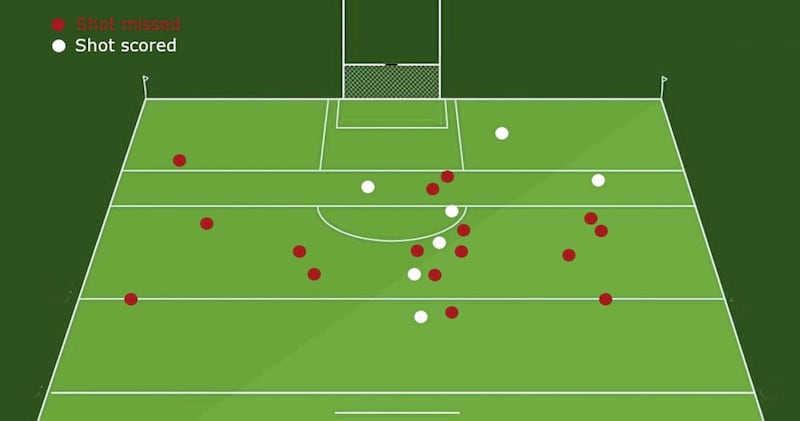
ARMAGH are a side that likes to kick the ball. They’ve done so through all of McGeeney’s reign, and when given space they are a very effective kicking team.
One of the biggest jobs their manager will have before they play Down is pick his starting forward line. If everyone is fit, he has to choose from Jamie Clarke, Stefan Campbell, Andy Murnin, Gavin McParland, Rian O’Neill and Ethan Rafferty for three positions in the full-forward line.
Throw in Oisin O’Neill’s impending return and the fact that Niall Grimley’s likely to play at wing-forward, and that Aidan Forker is playing wing-back largely to accommodate another good ball player in the side, and you have a depth that most other counties would love to have.
No matter what team McGeeney picks, it will be a team that prefers to kick. And that can be as big problem as it can be an asset.
The prime example is the Fermanagh game last year. Rory Gallagher’s side produced nothing that Armagh wouldn’t have known about in advance. They’d drawn 0-7 apiece in Brewster Park two months earlier, and Fermanagh had played the way they’ve played consistently under the former Donegal boss, who was the one to squeeze the life out of Armagh in 2015 as well.
Armagh were bigger on the whole than Fermanagh around the middle and for large periods of the game, they dominated possession. They created 38 attacks, from which they took 23 shots. They scored just 0-7, and all three of their second half scores were from frees.
Look at the map below, with particular focus on how many of those 23 shots were taken from out on the two wings or from around the Fermanagh 45’.
On top of that, they were turned over 18 times inside the scoring area. Of the 12 kicks they attempted to the full-forward line, they won just five. Fermanagh’s weight of numbers and organisation sealed off the middle of the goal completely, it cut off the kick, and it suffocated Armagh.
And they aren’t set up to run the ball. Even though five of their seven points came from moves without an attacking kick pass, it’s all very haphazard. To borrow a rugby term, it’s all one-up runners, heading into traffic and hoping for a free or that an orange shirt is somewhere near enough to pop the ball off to.
It ultimately became a very comfortable five-point win for the Ernemen, and provided evidence that Armagh would continue to struggle with such a setup.
What has changed?
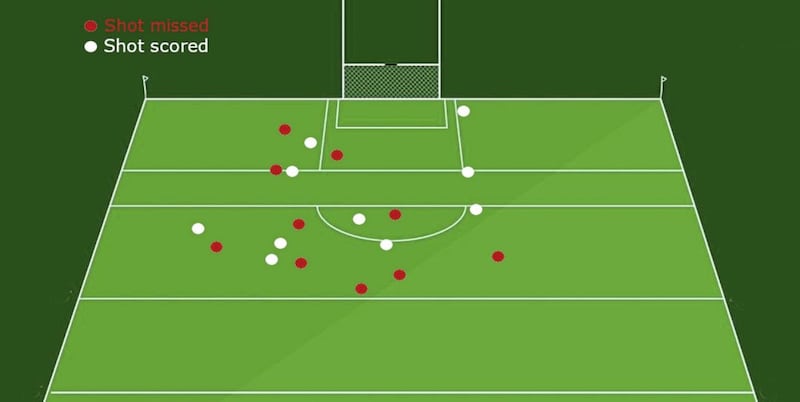
THEY’VE known since before the turn of the year that they’d be back in Newry first up this summer, and that Paddy Tally would be in charge of operations for Down.
It’s been no surprise to see the Mournemen operate a stringent counter-attacking game, based loosely around getting all their bodies back and then running the ball the length of the field.
That has its own limitations which Armagh will look to exploit, and indeed they’ll have looked at Louth’s win in Páirc Esler and saw that, in the right circumstances, the boot can still be the most effective counter-attacking weapon of all.
But only if it’s used right. And when you look back at last summer, Armagh’s kicking was at times desperate, and often only once any other ideas had been exhausted.
They allowed Fermanagh to get men back and then kicked Andy Murnin a load of ball that was 40-60 at best. When they ran it, they ran it in straight lines, with no support runners and often with no real pace.
Little surprise then that the stats say Fermanagh turned them over 18 times in their defensive 45’ that day, and that Armagh won just 66 per cent of the ball they kicked inside, scoring just a single point off it.
The Orchard were praised for how they changed it up when the sides met in the league in Crossmaglen in March. The numbers back up the theory to a point.
The turnovers they conceded in the attacking area were almost halved, from 18 down to 10. The percentage of kicks won went up to 81 per cent, and off it they scored 1-2.
But beyond that, it was largely about their mixture of patience and greater penetration.
Against a significant wind in the second half, they took nine shots. They scored 1-4 off it, and Tom Clarke made a fine save to deny Ethan Rafferty a second goal late on. Another effort was blocked. They kicked just two wides.
Contrast that with last summer, when they kicked eight wides with the wind and seven more against in Brewster Park.
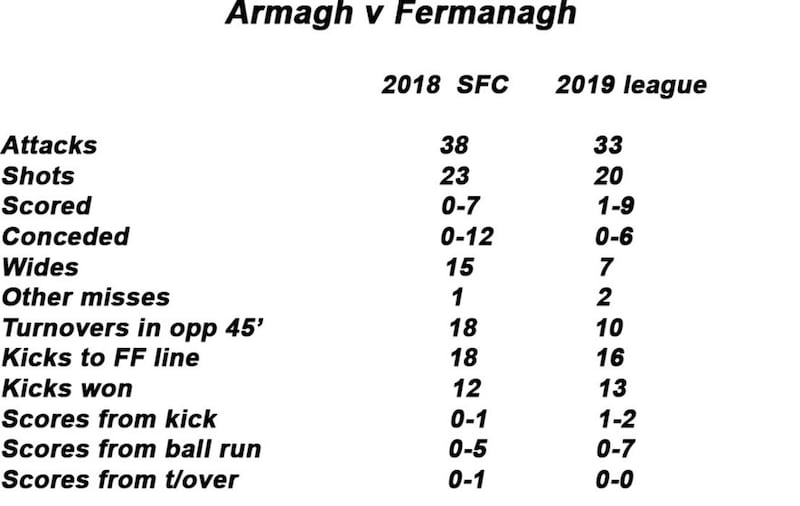
The Running Game
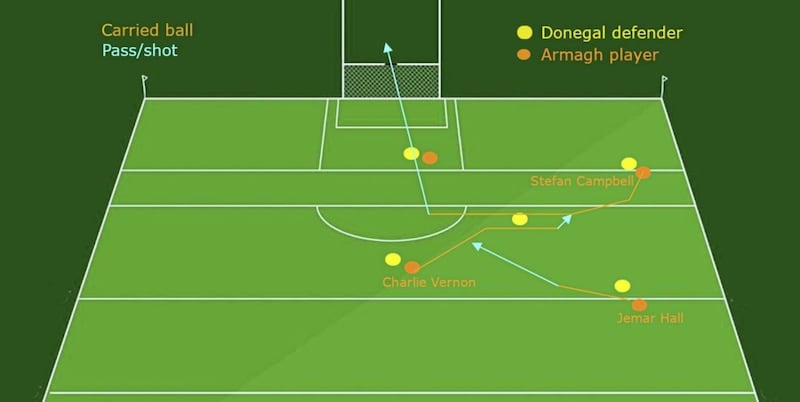
THIS is where the question remains. There’s no doubt that Armagh’s decision making has improved over the last six months. They’re making better judgement calls on when to kick the ball and when to run it.
That’s resulted in them being a more penetrative attacking force. Take their narrow league defeat in Ballybofey, where nine of their 11 points were kicked from within 27 metres of goal. On an horrendous night, their shot selection still wasn’t perfect, but it was better and eliminated a lot of the risk.
Their running game has also improved. Stefan Campbell, renowned more as a ball-winner, has actually been central to that, and Jamie Clarke to a point as well.
What they’ve brought to the team as much as anything is the ability to hold a wide position and then come in at pace and change the angle of attack at the right time.
Campbell did it three times in the first half against Donegal, hugging the touchline and then driving in-field. Armagh scored each time.
There are also a few key links from deep. Mark Shields is arguably their best at it. Jarlath Óg Burns and Ethan Rafferty are powerful, rangy runners that will open gaps, while Charlie Vernon is particularly adept at coming on to a ball hard off the shoulder.
But there is still an element of uncertainty about them when they try and play that way. An obvious pattern has been formed when they turn the ball over. A clutch of players will sprint to get ahead of the ball and hug the touchlines.
Yet there’s still a great degree of isolation in it. They’ll have a single runner in position but often with no support runner off him.
Jemar Hall has been a particular victim, someone who can run good angles but often finds himself heading into traffic with no help.
Thus there’s still a predictability about them when they run the ball. In trying to run at Fermanagh down the middle last year, they got eaten alive. But in trying to keep it wide through the league this year, teams have been able to keep them at arm’s length.
They’d scored just four goals in the first six games before they hit Cork for another three on the last day, and beyond that chances didn’t exactly flow freely.
They only scored four goals the last time they were in Division Two in 2016, compared with 8 (2018), 15 (2017) and 11 (2015) in their third tier campaigns under McGeeney.
Armagh have shown signs of improving their running game and look like they’re working on the changing of angles from out wide, but it seems very early in the process to think that their summer body will be sufficiently toned.

